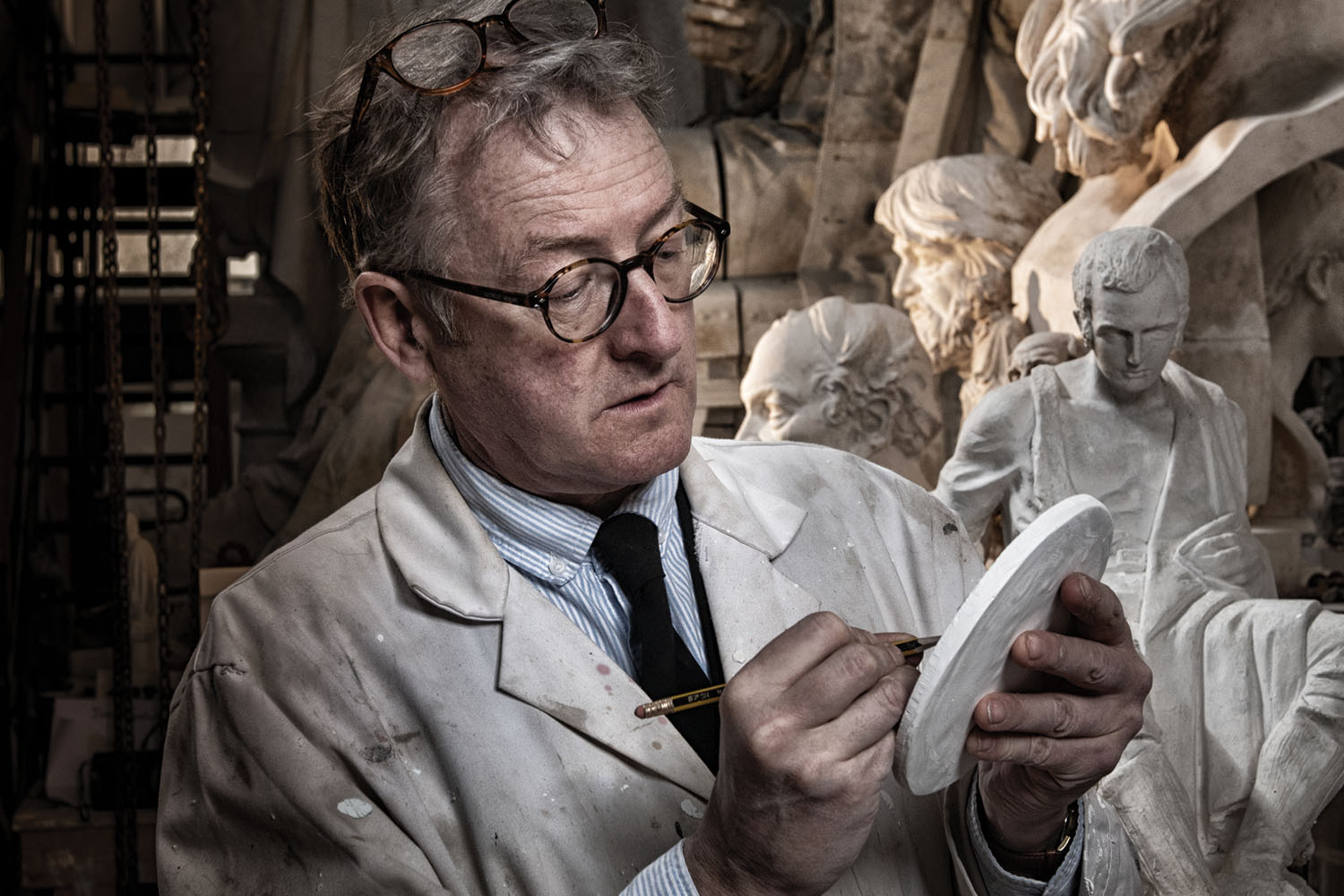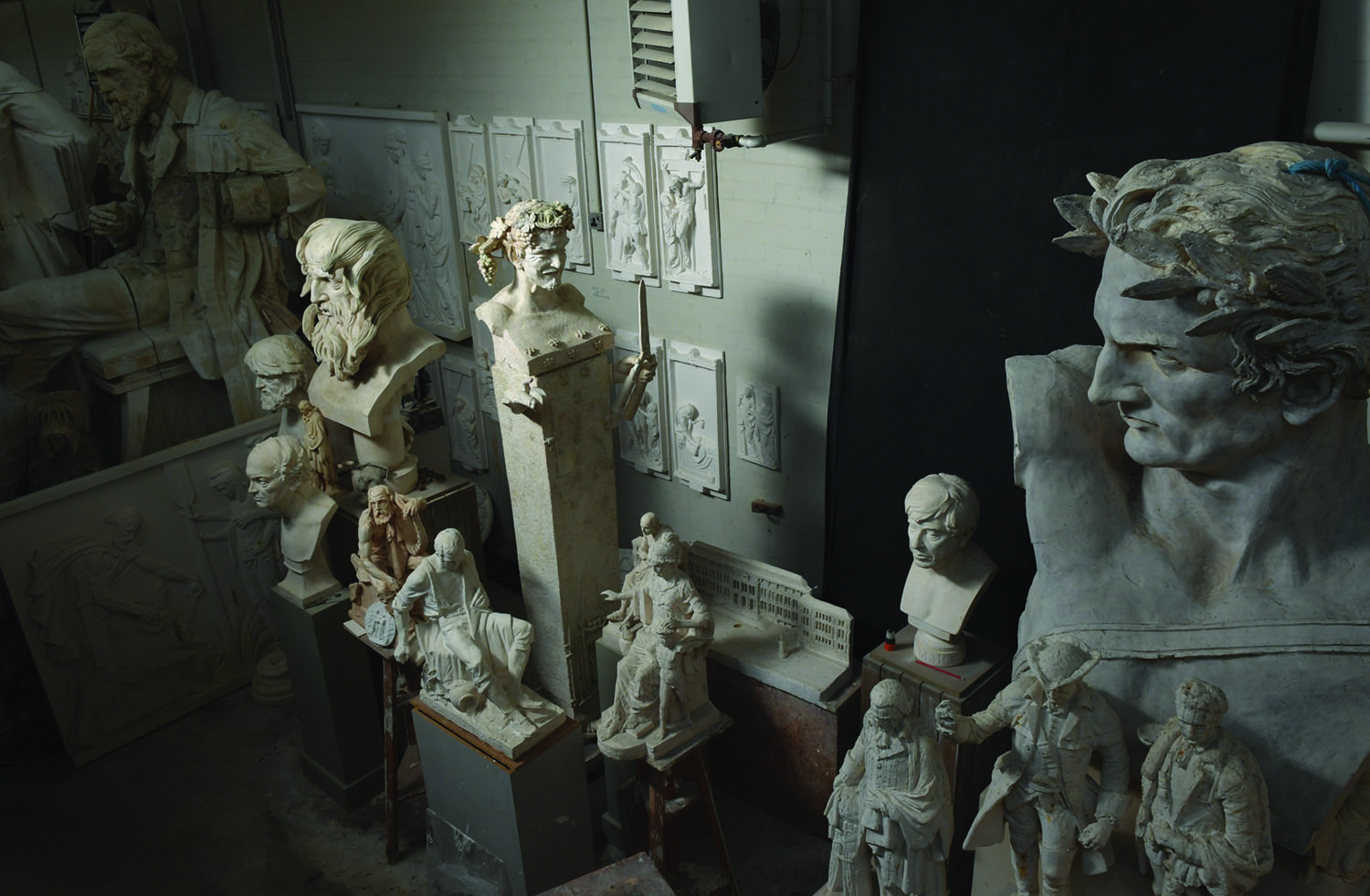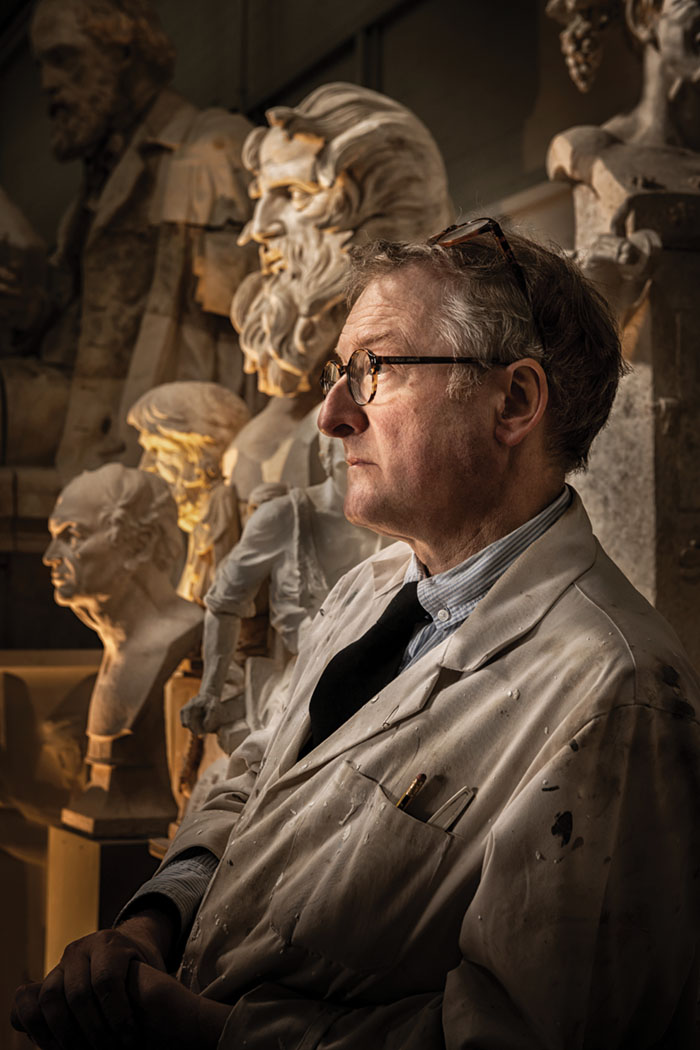
Alexander Stoddart speaks exclusively to Mill
For over three decades, Alexander Stoddart has been regarded as one of the finest sculptors in the world. Speaking exclusively to Mill, he talks about his childhood, his works, and his hopes to make more statuary and monuments for Paisley.
In the depths of The University of the West of Scotland’s Paisley campus, one of Renfrewshire’s greatest artistic exports is, as ever, hard at work. Despite the fact that he could be located in Edinburgh, Florence, the United States – or any other place where his work is in high demand – Alexander Stoddart chooses to make his highly lauded, neoclassical sculptures in the town he has always called home.
The seventh person to be honoured as Sculptor in Ordinary to Her Majesty The Queen in Scotland, his works can be seen everywhere from the Royal Mile in Edinburgh to the private collections of his many patrons, notably in England and America.
From the foundry in Nairn which casts his multi-tonnage monuments, to the stone-cutting workshops in Carrara which translate his full-scale models into their final marble form, the man known to his friends and colleagues by the diminutive ‘Sandy’ keeps an international economy afloat from within the very campus before which stands his statue of John Witherspoon, the Scots-born cleric and American revolutionary.
- Elderslie – a Mill Magazine local guide by Annie McGuire
- Ely Percy – Renfrew-born author of the award-winning book, Duck Feet
- Barnhill Farm Kitchen Inchinnan lunch review
Standing in his cavernous studios, filled with blank-eyed works gazing across empty space, this informal gallery can’t help but remind you of our own impermanence – and it’s a feeling that terrifies some while proving oddly comforting to some others, depending upon each person’s core disposition.
Above all, visitors are left bowled over by what can be accomplished through manual labour and an intense professional devotedness.
During our visit, Sandy reveals that a pressing commission is in hand, to make the largest crucifix in Europe (for a hilltop site near Venice, Italy). A five-year project, it will be completed as a 46-tonne bronze, to be transported by a Renfrewshire logistics company in a convoy of four lorries by sea and land.

Inside the studio, photo by Graeme Hewitson ©Mill Magazine
This follows his recently-completed colossus The Spirit of Duty now erected before the headquarters of George W. Bush, in Dallas, Texas. He tells us that he has had this latter work in mind since he was a child of eight or nine, when he first read of the ‘winged sentry’ in Henry Vaughan’s poem Peace, written around 1650.
Sculpture has been a fixture in his life for as long as he can remember. “My mother’s people are from Wick, up in Caithness. For holidays we’d drive up the Great Glen and throughout the journey we would see the memorials to the Dead of the Great War with their bronze and stone soldiers.
“As I grew into consciousness over those childhood years, these monuments would become ‘milestones’. I would anticipate the Crianlarich memorial in its comfortable aedicule, the icy Ballachulish soldier (white marble) by Loch Leven, and, above all, the heroic Commandos Memorial above Spean Bridge, a work of the 1950s by the Caithness man Scott Sutherland.

Alexander Stoddart, photo by Graeme Hewitson ©Mill Magazine
We were always moving by, in a rushing vehicle, bound by time and space – but these figures stood stern at their post, chivalrous, faithful and loyal. When we came to Golspie on the north-eastern coast, Ben Bragghie rising to our left, the parental chat in the car would turn dark. ‘…still a great deal of bitterness’ and ‘you wouldn’t mention it in company…’ and so on.
“We were beneath the statue of the Duke of Sutherland, perched on the mountain ‘s summit, the monument to the villain of the Clearances. I learned in this way of the special seriousness of monumentalism, and how it was not a matter of fun and games.
“Growing up in Elderslie, my friend Derek Shields and I would arm ourselves to the teeth as a gang of two, and fight for Sir William Wallace, the monument to whom stands at the bottom of the road where we lived. I remember my mother taking me around the base of this modest fane, telling me the story of the hero and his great struggle against tyranny and for the Scottish Crown. I conceived the idea that this was Wallace’s actual house, yet could never find the door.”
“Growing up in Elderslie, my friend Derek Shields and I would arm ourselves to the teeth as a gang of two, and fight for Sir William Wallace”
His late father was a graphic designer, also a son of the manse. As such, he had been forbidden to go to Art School, since such places were regarded in close Church circles as “dens of iniquity”. He was put to the printing trade in a Christian firm.
The force of Sandy’s parental support was immense, with a crucial emphasis on musical culture. He attended the John Neilson school out by Ferguslie. Then, there was the Glasgow School of Art and a First Class Honours degree which was originally to be a Third, but by some error became a low First.
Defining himself as a ‘perceptualist’ rather than a ‘conceptualist’, Stoddart, who has so often been characterised as an art-world rebel owing to his traditionalist commitment, has rebuffed the notion that he is in any way subversive. “An arts-commissar recently told me that I like to be different and to upset people,” he remarks. “That’s terribly wrong. In fact, what I like to do is get to the studio at a respectable time in the morning, fulfil my work obligations, pay my taxes and make some kind of contribution to the community.”

Photo by Graeme Hewitson ©Mill Magazine
Considering that his work stands in diverse locales around the western world, it’s fair to say that Stoddart isn’t a man with an abundance of unfulfilled ambitions or regrets. However, when it comes to Paisley, here is one of the areas in which he has felt peculiarly frustrated.
“Perhaps it is all to do with my still being here, and working in my hometown, that makes for the difficulty. I mean, I successfully reorganised the street outside the National Museum of Scotland, to make a new square for our capital city, yet there is an absolute silence from the arts authorities in Renfrewshire. I await the ‘Wow!’ signal each day… but nothing.”
Stoddart is enchanted by such artists as the poet Tannahill and Glasgow’s Alexander ‘Greek’ Thomson; artists who were ‘incredibly localised.’ His longest-held Paisley aim is to make a serious monument to the Communist MP William Gallacher, and also one to the architect Thomas Tait, a Paisley boy who built the Sydney Harbour Bridge and became the most famous British architect of his time. Nevertheless, Sandy believes there will “sooner be a manned mission to Mars” before these plans come to fruition.
He remains facetious and cheerful, however, and is still working on plans to build, in Paisley, a Gipsoteck museum (a collection of plaster models and studies) to hold his vast collection after his death.
“This would allow people to see works in their original plaster form,” he details, “here in Paisley, even though their bronze and marble versions are widely dispersed across the world. Many sculptors have left their collections to their hometowns; this would be my contribution.”
Alexander Stoddart Quickfire Q&A
Favourite place for coffee? UWS Café
Favourite place for lunch? Allan’s Traditional Fish and Chip Restaurant
Favourite place for dinner? Kwang Tung
Favourite view of Paisley? Looking down from the top of Gallowhill Road, by the roundabout
Favourite piece of art? Tristan and Isolde, an opera by Richard Wagner
For more Mill Magazine interviews, please click here.
